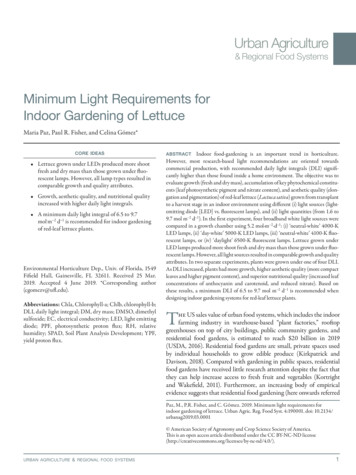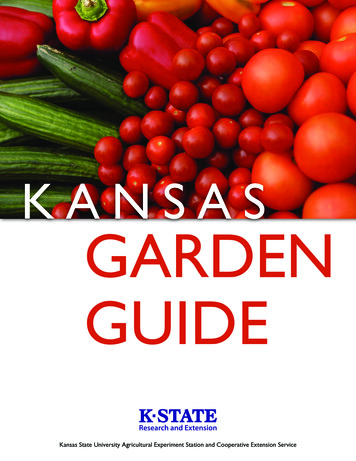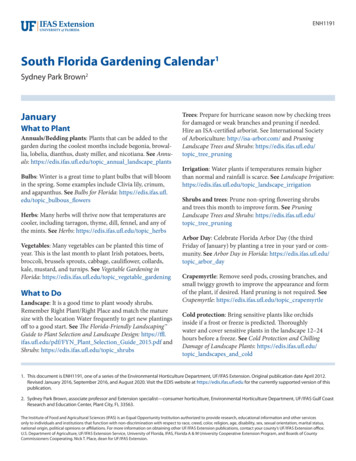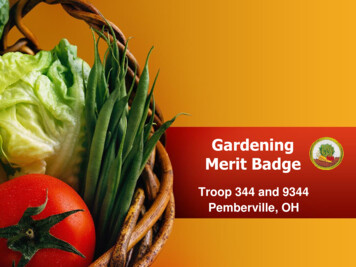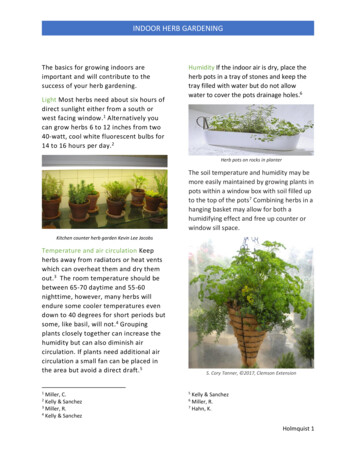
Transcription
INDOOR HERB GARDENINGThe basics for growing indoors areimportant and will contribute to thesuccess of your herb gardening.Light Most herbs need about six hours ofdirect sunlight either from a south orwest facing window.1 Alternatively youcan grow herbs 6 to 12 inches from two40-watt, cool white fluorescent bulbs for14 to 16 hours per day.2Humidity If the indoor air is dry, place theherb pots in a tray of stones and keep thetray filled with water but do not allowwater to cover the pots drainage holes.6Herb pots on rocks in planterThe soil temperature and humidity may bemore easily maintained by growing plants inpots within a window box with soil filled upto the top of the pots7 Combining herbs in ahanging basket may allow for both ahumidifying effect and free up counter orwindow sill space.Kitchen counter herb garden Kevin Lee JacobsTemperature and air circulation Keepherbs away from radiators or heat ventswhich can overheat them and dry themout.3 The room temperature should bebetween 65-70 daytime and 55-60nighttime, however, many herbs willendure some cooler temperatures evendown to 40 degrees for short periods butsome, like basil, will not.4 Groupingplants closely together can increase thehumidity but can also diminish aircirculation. If plants need additional aircirculation a small fan can be placed inthe area but avoid a direct draft. 5S. Cory Tanner, 2017, Clemson Extension1526Miller, C.Kelly & Sanchez3Miller, R.4Kelly & SanchezKelly & SanchezMiller, R.7Hahn, K.Holmquist 1
INDOOR HERB GARDENINGContainers for growing indoor herbsAs noted above, you can use single pots orcontainers large enough for multiple herbsbut whichever you choose you must haveadequate drainage at the bottom of thepots/containers. If you start with small potsyou will probably have to repot as the herbsgrow. They may need some additional rootspace and those roots will be needed tosupport the plant as it grows larger overtime.Water regularly and thoroughly with roomtemperature water. Bay, marjoram,oregano, sage, and thyme need to dry outbetween watering.9 Certain herbs such asbay (Laurus nobilis), marjoram and oregano(Origanum spp.), sage (Salvia officinalis),and thyme (Thymus spp.) should dry outslightly between waterings, however,rosemary (Rosmarinus officinalis) shouldnever be allows to dry out ing.com/article/how-to-repot-containerplantsRepot the herbs when the roots start togrow through the drainage holes. If you arecombining herbs in a planter allow for thetap root herbs like borage (BoragoOfficinalis) or Dill (Anethium graveolens) tohave sufficient depth while the non-taprootherbs that are more trailing can take up theupper portion of the planter.8Watering the herbsMost herbs will benefit from occasionalfeeding, approximately every two weeks orper the manufacturer’s instruction, with aliquid fertilizer, such as fish emulsion,seaweed or a general-purpose, watersoluble fertilizer.11 Too-vigorous growth willproduce foliage low in essential oils andtherefore bland taste.12SoilHerbs need a well-drained soil that is nottoo rich.13 The Soil should have a pH of 6-7and contain a moderate amount of organic811912Kelly & SanchezKelly & Sanchez10University of MDMiller, C.MacKinsey13University of MDHolmquist 2
INDOOR HERB GARDENINGmatter.14 If you are using potting soil, checkthe label to make sure it complies withthese properties.HarvestingSeed production will also hasten the end ofany annual herb's life.For carrot-family herbs, cut each leaf stalkat the base of the plant, rather than justtrimming off the tender leaf blades ofparsley or cilantro, or the ferny growth ofdill. For these plants as well, floweringsignals the end of the plant's life, and theflavor of the foliage may not be as pleasantonce the plant flowers. ”16Cooking with HerbsDenny Schrock, Herb Care GuideFor most indoor grown herbs, you will beharvesting leaves but you can pick flowersand use them together with the leaves.15According to MacKensey of the Universityof Minnasota, “many herbs will contain thebest flavor if harvested just beforeflowering. For mint-family herbs, make thecut a few inches down the stem and justabove a set of leaves. New growth will arisefrom buds at this point, and a bushier plantwill result. This is especially important withannual herbs such as basil and marjoram,which can become woody, less productive,and somewhat bitter if allowed to set seed.1415Kelly & SanchezMiller, C.There are two schools of thought on addingherbs to your cooking. Some people thinkthey should be added at the end of thecooking.17 however, they can be added atthe beginning and at the completion ofcooking, additional herbs can be added totaste. According to Browing, when usingfresh herbs in a recipe that calls for driedherbs, the general guideline is to use 3times the amount of dried herbs indicated.1617MacKinseyBrowningHolmquist 3
INDOOR HERB GARDENINGChiveOreganowww.google.com/search?q pictures of chiveswww.google.com/search?q picture of oreganoGreek Oregano, O. vulgare is a lowspreading herb with peppery flavoredpale green ½ to 1-inch fuzzy leaves, anderect reddish stems.22 The leaves canbe harvested any time after the plant is6 inches tall.23 Seed propagated plantsoften do not come true from seed so itis suggested to obtain plants grownfrom cuttings.24 O. vulgare is the bestoregano for culinary purposes. Use onlythe leaves unless you plan to removethe sprigs after cooking.Lore: Created by Aphrodite as a symbolof happiness. Aristotle considered it anantidote to poisoning.25The chive plant, Allium schoenoprasum, is amember of the onion family (Alliaceae) andits grass-like hollow leaves have a mildonion flavor.18 Keep Chive damp and don’tallow it to dry out.19 Harvest chives bysnipping leaves from the base of the plant.Chive is also one of the “fine” herbs used inFrench cooking.Lore: Chive was among the herbsCharlemagne listed in 812 to be grown inthe imperial gardens.20 Marco Polo broughtChive back from China.2118221923Bremness, p. 40.Boxer20Dombik21Bremness, p. 40.Bremness, p. 104Browning24University of Illinois Extension.25Bremness, p. 104Holmquist 4
INDOOR HERB GARDENINGThymeGood Luck on the Indoor Herb Gardenwww.google.com/search?q pictures of thymeThere are many varieties of this herb,but the most popular and flavorful isCommon thyme (T. vulgaris), which islow growing with 4-8 inch square wirystems with aromatic, pointed oval greygreen leaves.26 Thyme is also one of thetruly “fine” herbs used in Frenchcooking.Use sprigs in cooking and remove or useonly the leaves of Thyme if leaving thisherb in a prepared dish.Lore: In Greek thyme means courageand was worn into battle as well as usedas an antiseptic to ward off disease.2726Bremness, p.142.Bremness, p. 2427DombekHolmquist 5
INDOOR HERB GARDENINGReferencesBoxer, A., & Back, P., The herb book. W.H. Smith Publisher, London, GB. 1990.Bremness, L. The complete book of herbs: A practical guide to growing and using herbs. Viking Studio Books,London, GB. 1988.Browning, S, (2011, November). Growing Herbs Indoor: Thyme, Oregano, Sage. Institute of Agriculture and NaturalResources. Nebraska Extension in Lancaster /InsideHerbs.shtmlDombek, R. (1992). An herb notebook. Essex, VT: Talk About (self-published/copyrighted)Hahn, K. (2017, 12/18) Michigan State University Extension retrieved 4/15/18 fromhttp://msue.anr.msu.edu/news/grow herbs indoors for a winter school gardenKelly, K. & Sanchez, E. (2002) Penn State College of Agricultural Science and Extension Service. Retrieved 4/2/18from Kenzie, J. (2007). Herbs. University of Minnesota Extension. Retrieved 4/15/18 en/vegetables/herbs/Miller, C. Growing herbs indoors. University of Illinois College of Agricultural, Consumer & Environmental Sciences.Retrieved 4/3/18 from 540.pdfMiller, R. ed. (2008) Life Times Vol. 10, no 1. University of Missouri Extension. Retrieved 4/3/18 es/Growing%20herbs%20indoors.htmlUniversity of Maryland Extension. Herbs in containers and growing indoors. Home and Gardening InformationCenter. Retrieved 4/4/18 from ners-and-growing-indoorsUniversity of Illinois Extension. (2018) Herb gardening: Greek oregano. University of Illinois Retrieved 4/16/18from sentation by Carol Holmquist and Liz ParkerVermont Master GardenersMay 8, 2018Accompanying power point available upon request.Holmquist 6
Kitchen counter herb garden Kevin Lee Jacobs Temperature and air circulation Keep herbs away from radiators or heat vents which can overheat them and dry them out.3 The room temperature should be between 65-70 daytime and 55-60 nighttime, however, many herbs will endure some cooler t
